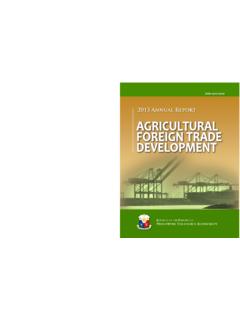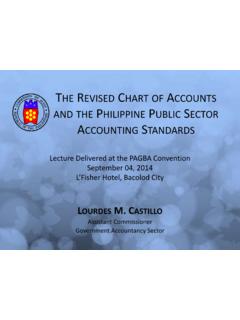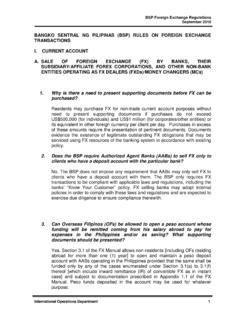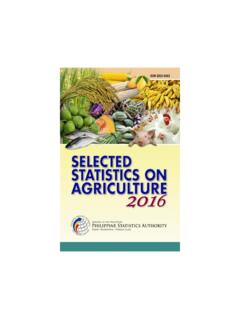Transcription of 2009 Philippine Standard Industrial Classification
1 Republic of the Philippines PAMBANSANG LUPON SA UGNAYANG PANG-ISTADISTIKA (NATIONAL STATISTICAL COORDINATION BOARD) 2009 Philippine StandardIndustrial ClassificationISBN-971-91792-1-4 2009 Philippine Standard Industrial Classification The 2009 Philippine Standard Industrial Classification is a publication prepared by the Standards and Classification Systems Division of the NATIONAL STATISTICAL COORDINATION BOARD (NSCB). For Technical inquiries, please direct calls at : (632) 890-3135/897-1773. TERMS OF USE NSCB PUBLICATIONS The NSCB reserves its exclusive right to reproduce all its publications in whatever form. Any part of this publication should not be reproduced, recopied, lend or repackaged for other parties for any commercial purposes without written permission from the NSCB. Any part of this publication may only be reproduced for internal use of the recipient/customer company. Should any portion of the data in this publication are to be included in a report/article, the source of the data, the title of the publication and the NSCB as publisher should always be cited.
2 Any information derived from the manipulation of data contained in the publication will no longer be the responsibility of NSCB. Please direct your subscription and inquiries to the: NATIONAL STATISTICAL INFORMATION CENTER National Statistical Coordination Board Ground Floor Midland Buendia Bldg., 403 Sen Gil Puyat Avenue, Makati City Tel. nos.: Telefax nos.: (632) 895-2767 (632) 890-8456 (632) 890-9405 FOREWORDThe 2009 PhilippineStandardIndustrialClassificati on(PSIC)presentsthe latestrevisionon the country'sstandardindustrialclassificatio nundertakenby the NationalStatisticalCoordinationBoard(NSC B)in collaborationwith concernedagenciesin thePhilippineStatisticalSystem(PSS).The PSICis a detailedclassificationof industriesprevailingin the countrybasedon the productiveactivitiesundertakenby servesas a guidein theclassificationof establishmentsaccordingto theirprimaryeconomicactivitywhichisusefu lfor also servesas a frameworkfor datacollection,processingandcompilationt o secureuniformityand comparabilityof industrialstatisticsproducedbyboth governmentand privatesectorsin the 2009 PSIC waspatternedafterthe UnitedNationsInternationalStandardIndust rialClassification(UN-ISIC)Revision4, but withsomemodificationsto reflectnationalsituationand its previouseditions,it guaranteesinternationalcomparabilityof statisticsrelatingto economicactivitiesof industriesand establishmentsgeneratedin the NSCB periodicallyrevisesthe country'sindustrialclassificationsystemt o: (a)reflectchangesin the economicactivities,suchas the emergenceof new industries.
3 (b)takeinto accountthe newtechnologiesemployedwhichaffectthe organizationofproductionand shiftingof economicactivities;and (c) realignwith the UN-ISIC revisionsfor purposesof variouseconomicactivitiesbroughtaboutby the introductionof newtechnologiesand the emergenceand growingimportanceof new industriesespeciallyinthe BusinessProcessOutsourcing(BPOs),suchas Back-officeoperationsactivities;Engineer ingoutsourcingactivities;and Informationand CommunicationsTechnology(ICT)activities, suchas Internetcafe,VoiceoverInternetProtocol(V OIP)services;andotherrelatedindustrieswh ichwerenot in the 1994 PSICare incorporatedin the preparationof the 2009 PSICwas madepossiblewith the guidanceof theTechnicalWorkingGroupon IndustrialClassification(TWG-IC)chairedb y the BureauofExportsand TradePromotions(BETP)of the Departmentof Tradeand Industry(DTI)underthe NSCBT echnicalCommitteeon StatisticalStandardsandClassifications(T CSSC).
4 Pursuantto NSCBR esolutionNo. 2 Seriesof 2010,all concernedgovernmentagenciesand instrumentalitiesare enjoinedto adoptthe :=::A'- --rROMULOA. VIROL~C/SecretaryGeneralRepublika ng Pilipinas PAMBANSANG LUPON SA UGNAYANG PANG-ESTADISTIKA (NATIONAL STATISTICAL COORDINATION BOARD) 1st, 2nd & 5th Floors Midland Buendia Building 403 Sen. Gil J. Puyat Avenue, Makati City 1200 NSCB Resolution No. 2 Series of 2010 APPROVING AND ADOPTING THE 2009 Philippine Standard Industrial CLASSSIFICATION (PSIC) WHEREAS, Standard Classification systems are used to achieve uniformity and comparability of statistics generated at the national and international levels; WHEREAS, the National Statistical Coordination Board (NSCB) develops and prescribes uniform standards and Classification systems in the generation of official statistics to ensure harmonization of statistics in the country and at the international level; WHEREAS, one of the Classification systems being maintained by the NSCB is the Philippine Standard Industrial Classification (PSIC), which is based on the International Standard Industrial Classification (ISIC) issued by the United Nations Statistics Division (UNSD).
5 WHEREAS, the current 1994 PSIC was amended in 2002 based on the ISIC Rev. issued by the UNSD in the same year; WHEREAS, the UNSD issued ISIC Rev. 4 in August 2008 in order to reflect new industries, new production pattern and new needs for economic analysis, as well as to improve linkages to major regional classifications; WHEREAS, the NSCB Technical Committee on Statistical Standards and Classifications (TC-SSC), through its Technical Working Group on Industrial Classification (TWG-IC), has reviewed and recommended the 2009 Philippine Standard Industrial Classification (PSIC) which is aligned with the ISIC Rev. 4, taking into account the significant changes on the relative importance of various economic activities in the country that have taken place since 2002; WHEREAS, the ASEAN Heads of Statistical Offices Meeting (ASHOM) approved in November 2006 the ASEAN Common Industrial Classification (ACIC) based on ISIC Rev.
6 4 which was developed by the ASEAN Task Force on the Harmonization of Industrial Classifications for adoption by the ASEAN member countries; NOW, THEREFORE, BE IT RESOLVED, AS IT IS HEREBY RESOLVED, that the NSCB Executive Board approve the 2009 PSIC with correspondence codes to link with the ACIC, for adoption by concerned government agencies and instrumentalities. Approved this 10th day of February 2010 in Pasig City. Attested by: (Sgd) ROMULO A. VIROLA Secretary General Republika ng Pilipinas PAMBANSANG LUPON SA UGNAYANG PANG-ESTADISTIKA (NATIONAL STATISTICAL COORDINATION BOARD) 1st, 2nd & 5th Floors Midland Buendia Building 403 Sen. Gil J. Puyat Avenue, Makati City 1200 NSCB MEMORANDUM CIRCULAR NO. ___ TO: All Agencies of the National and Local Government, Government-Owned and/or Controlled Corporations Involved in the Statistical Activities of the Government SUBJECT: Guidelines for the Adoption and Use of the 2009 Philippine Standard Industrial Classification (PSIC) Pursuant to NSCB Resolution No.
7 2, Series of 2010 approved on the 10th day of February 2010 entitled, Approving and Adopting the 2009 Philippine Standard Industrial Classification (PSIC), the following guidelines are hereby issued: 1. Purpose and Uses of the 2009 PSIC The 2009 Philippine Standard Industrial Classification (PSIC) is a detailed Classification of industries prevailing in the country according to the kind of productive activities undertaken by establishments. For purposes of international comparability, the 2009 PSIC is patterned after the United Nations International Standard Industrial Classification , Revision 4 (ISIC Rev 4) with some modifications to suit national situation and requirements. The 2009 PSIC is the latest version released by the NSCB after the 1994 PSIC was amended in 2002. The PSIC serves as a guide in the Classification of establishments according to their economic activity useful for economic analysis.
8 It serves as a framework for data collection, processing and compilation to ensure uniformity and comparability of Industrial statistics produced by various entities in both government and private sectors. It provides an effective mechanism for the integration and aggregation of data being collected for decision-making and policy formulation. It serves as a basis in the construction of input-output (I-O) tables, and it provides a basis for anticipating the emergence of new industries. 2. Scope of the 2009 PSIC Similar to the UN ISIC Rev. 4, the 2009 PSIC is a Classification according to kind of economic activity. Thus, its scope has historically been restricted to the Classification of units engaged in economic production as defined by System of National Accounts (SNA), which states: Economic production is an activity, carried out under the responsibility, control and management of an institutional unit, that uses inputs of labour, capital, and goods and services to produce outputs of goods and services (ISIC Rev 4).
9 Although the scope of the present version of PSIC is defined by the productions boundary of the SNA, there is still one exception activities in PSIC class 9820 (Undifferentiated services-producing activities of private households for own use.). This type of activity, in combination with class 9810 (Undifferentiated goods-producing activities of private households for own use), is used for measuring subsistence activities of households that can not otherwise be captured in the Classification . Class 9810 and 9820, however, cover only a part or subset of all household consumption, because households with clearly identifiable economic activities (whether market or for own final use) are classified in other parts of the 2009 PSIC. These categories have been created for special purposes, such as labor force surveys, to cover combinations of household activities that would otherwise be difficult or impossible to assign to a single PSIC category.
10 These two categories are generally not used in business surveys in the country. 3. Summary of Classification Scheme The 2009 PSIC provides a Summary of Classification Scheme which presents a list of sections, divisions, and their corresponding number of groups, classes and sub-classes, and a Detailed Classification presenting the hierarchy of categories of industries such as: 21 sections (one-digit alphabetic codes) 88 divisions (2-digit codes) 245 groups (3-digit codes) 520 classes (4-digit codes) The 2009 PSIC further enhances the relevance of the Standard Industrial Classification by better reflecting the existing structure of the world economy, recognizing new industries that have emerged over the past 20 years and facilitating international comparison through increased comparability with existing regional classifications in the world.









